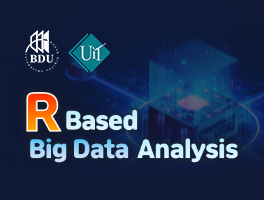
- Gil-Dong Hong
- Fusionsoft
- Computer Engineer
- Hello, Let me introduce myself...
- fusionsoft@fusionsoft.co.kr

This course provides the basic usage of the R programming language for big data analysis, as well as fundamental theories and practical skills in data cleansing, processing, visualization, modeling, and prediction using R. The course is structured into three modules to cover the understanding of big data analysis, theoretical aspects, and practical applications of R progamming in big data analysis.
The goal is to understand the concept and characteristics of big data and acquire knowledge on how to collect and analyze big data and using the R programming language
Period : December 1, 2023 ~ March 15, 2024
Intermediate
To complete this course successfully, you should have:
1. A basic knowledge of teaching/learning(pedagogy)
2. Some instructing or instructional design experience
3. Fluency of English
| Item | Title | Score(Rate) | Implementing Week | Method | Remarks |
|---|---|---|---|---|---|
| Assignment | |||||
| Discussion | |||||
| Midterm | |||||
| Final Exam | |||||
| Total | 100 | ||||
| Topics and activities | Content name and URL | Remarks |
|---|---|---|
PHP 4 Web Programming, Lee, 2002


What does this course cover specifically?
You can learn about various medical engineering fields such as anatomy, physiology, medical mechanical engineering, biomaterial engineering, electronic medical equipment, medical imaging, etc. and problem solving based on actual cases.
Do you have a separate course textbook?
Here are some basic and detailed books on this course: However, based on the weekly lecture data file, the contents of each unit are summarized. (Introduction to Biomedical Engineering, Third Edition, John Enderle (ISBN: 0122386620), Elsevier Academic Press)